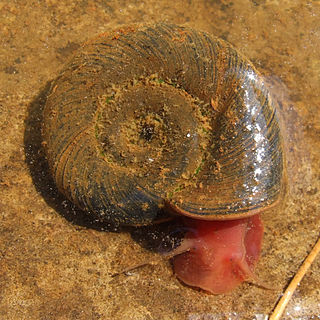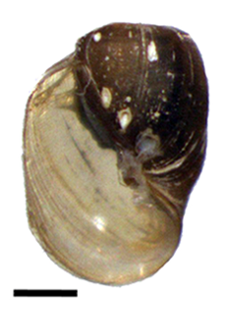
Planorbidae, common name the ramshorn snails or ram's horn snails, is a family of air-breathing freshwater snails, aquatic pulmonate gastropod molluscs. Unlike most molluscs, the blood of ram's horn snails contains iron-based hemoglobin instead of copper-based hemocyanin. As a result, planorbids are able to breathe oxygen more efficiently than other molluscs. The presence of hemoglobin gives the body a reddish colour. This is especially apparent in albino animals.

Planorbarius corneus, common name the great ramshorn, is a relatively large species of air-breathing freshwater snail, an aquatic pulmonate gastropod mollusk in the family Planorbidae, the ram's horn snails, or planorbids, which all have sinistral or left-coiling shells.

The Australian freshwater limpet or Tasmanian freshwater limpet, scientific name Ancylastrum cumingianus, is a species of air-breathing freshwater snail or freshwater limpet, an aquatic pulmonate gastropod mollusc in the family Planorbidae. This species is endemic to freshwater lakes in the Central Plateau of Tasmania.
Beddomeia camensis is a species of very small freshwater snail that is endemic to Australia. The invertebrate is 2-4 mm in size, it is a gastropod mollusk and belongs to the Hydrobiidae family, a large family of freshwater snails recognised by their small size and cosmopolitan distribution. Beddomeia camensis is one of the least populated species within its family distributed across only 5 small to medium-sized streams that flow into the Cam River catchment in North-West Tasmania.
Glyptophysa is a genus of medium-sized sinistral (left-handed) air-breathing freshwater snails, aquatic pulmonate gastropod mollusks in the family of Planorbidae.
Carnarvonchochlea exigua, more commonly known as Jardinella exigua is a small freshwater snail residing in North East Queensland, near Carnarvon Gorge. Carnarvoncochlea refers to the location of origin, whilst exigua derives from the latin word "exigus" meaning "small".
†Neoplanorbis smithi was a species of small freshwater snail, an aquatic gastropod mollusk in the family Planorbidae, the ramshorn snails. This species was endemic to the United States; it is now extinct. The shells of this species appear to be dextral in coiling, but as is the case in all planorbids, the shell is actually sinistral. In life the shell was carried upside down with the aperture on the right, and this makes it appear to be dextral.

Neoplanorbis tantillus is a species of very small air-breathing freshwater snail, an aquatic gastropod mollusk in the family Planorbidae, the ram's horn snails. This species is endemic to the United States. In 2012, it has been declared extinct by the IUCN Red List of Threatened Species.
Notopala is a genus of moderately large to large, freshwater snails with an operculum, aquatic gastropod mollusks in the family Viviparidae, the river snails or mystery snails.
Trochidrobia inflata is a species of very small freshwater snail, an aquatic gastropod mollusk in the family Tateidae. This species is endemic to Australia. Trochidrobia inflata derives the name inflata from the inflated shell of this species.
Menetus dilatatus is a species of small air-breathing freshwater snail, an aquatic pulmonate gastropod mollusk in the family Planorbidae, the ram's horn snails.

Biomphalaria havanensis, common name the ghost rams-horn, is a species of air-breathing freshwater snail, an aquatic pulmonate gastropod mollusk in the family Planorbidae, the ram's horn snails.

Indoplanorbis is a genus of air-breathing freshwater snail. Its only member species is Indoplanorbis exustus, an aquatic pulmonate gastropod mollusk in the family Planorbidae, the ram's horn snails. The species is widely distributed across the tropics. It serves as an important intermediate host for several trematode parasites. The invasive nature and ecological tolerance of Indoplanorbis exustus add to its importance in veterinary and medical science.
Isidorella is a genus of air-breathing freshwater snails, aquatic pulmonate gastropod mollusks in the family Planorbidae, the ram's horn snails.
Austropyrgus ronkershawi is a species of minute freshwater snail with an operculum, an aquatic gastropod mollusc or micromollusc in the Hydrobiidae family. This species is endemic to Tasmania, Australia. It is known from a number of small streams and rivers in central northern Tasmania.

Stenomelania denisoniensis is a very variable species of freshwater snail, an aquatic gastropod mollusk in the family Thiaridae. Stenomelania denisoniensis has a long, slender shell and small aperture. This species has a characteristic angled shoulder just below the suture. This shoulder may be strong in some individuals and weak in others even if they are part of the same population.

Velesunio is a genus of medium to large sized mussels in the family Hyriidae.
Glyptophysa novaehollandica is a freshwater species of gastropod mollusk in the family Planorbidae.

Amerianna carinata is a species of freshwater air-breathing snails, aquatic pulmonate gastropod mollusks in the family Planorbidae, the ram's horn snails, or planorbids. Like all other planorbids it has a sinistral or left-coiling shell.







